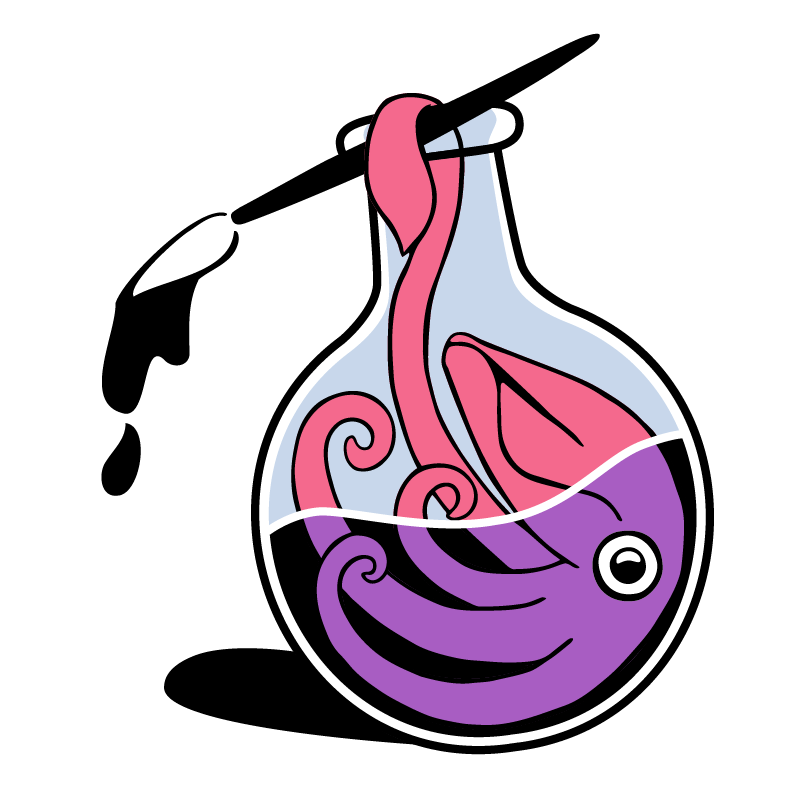Complex III - Cytochrome bc1 Complex
Complex III is the location of the Q cycle and the final destination for molecules of ubiquinone shuttling electrons from Complexes I and II. Electrons are transferred from Complex III to Complex IV by the mobile electron carrier Cytochrome c. During this process, CIII translocates 4H⁺ across the inner membrane.
Explore the 3D structure of Complex III:
Complex III (CIII) is a dimeric protein complex in the electron transport chain (ETC) and is the destination for QH₂ molecules from CI and CII. CIII is characterized by two Rieske Iron-Sulfur [Fe-S] protein subunits (green/blue), cytochrome c1 (pink/purple), and two cytochrome b proteins, bH and bL (yellow/orange).
Click the annotations to see the heme groups within the cytochrome proteins:
Explore the 3D structure of Cytochrome c
Cytochrome c (cyt c) is a mobile electron carrier like ubiquinone, except instead of traveling through the membrane, it rolls on top of it. Cyt c is a small protein with a heme c molecule inside of it. At the center of heme c is an iron (Fe) ion, which alternates between an Fe³⁺ and Fe²⁺ oxidation state, which allows cyt c to shuttle electrons from CIII to CIV.
A Closer Look at Complex III
Within CIII are two Rieske Iron-Sulfur Protein subunits.
These subunits are characterized by a 2[Fe-S] molecule and a cytochrome c1 protein, which contains a heme c1 molecule.
Just below the Rieske subunits is a cytochrome b protein.
It contains the heme groups bL and bH, which act as electron carriers.
In the redox reactions involving these proteins, the iron ions in 2[Fe-S] clusters and heme groups alternate between Fe³⁺ and Fe²⁺ oxidation states.
The Q Cycle
Cycle I
-
Ubiquinol, QH₂, is delivered via the inner membrane from CI and CII and binds to the QH₂ oxidation site, Q₀. A molecule of ubiquinone, Q, binds the Qᵢ site.
-
Ubiquinol is then oxidized to a semiquinone radical (·QH) by the 2[Fe-S] cluster in the Rieske subunit. This electron then is taken up by the other molecule in the Rieske subunit, heme c1.
QH2 → ·QH + e- + H⁺
Rieske (Fe³⁺) + e- → Rieske (Fe²⁺)
-
Heme c1 then transfers the electron to the mobile electron carrier, cytochrome c, which rolls over the top of the lipid bilayer to CIV.
heme c1 (Fe²⁺) → heme c1 (Fe³⁺) +e-
cyt c (Fe³⁺) + e- → cyt c (Fe²⁺)
-
The semiquinone radical is further oxidized to ubiquinone by heme bL. Ubiquinone leaves the Q₀ site.
·QH → Q + e- + H⁺
heme bL (Fe³⁺) + e- → heme bL (Fe²⁺
-
Heme bL then transfers the electron to heme bH. Heme bH then reduces a molecule of ubiquinone (bound to the Qi site) to form a semiquinone radical.
heme bL (Fe²⁺) → heme bL (Fe³⁺) + e-
heme bH (Fe²⁺) → heme bH (Fe³⁺) + e-
Q + e- + H⁺ → ·QH
Cycle II
-
A second molecule of ubiquinol binds to the Q₀ binding site. Ubiquinol transfers one electron to the 2[Fe-S] cluster in the Rieske subunit.
QH₂ → ·QH + e- + H⁺
Rieske (Fe³⁺) + e- → Rieske (Fe²⁺)
-
The electron is then transferred to heme c1 in the Rieske subunit. Heme c1 is oxidized by cytochrome c, which then heads over to CIV.
heme c1 (Fe²⁺) → heme c1 (Fe³⁺)
cyt c (Fe²⁺) → cyt c (Fe³⁺)
-
The semiquinone radical is then further oxidized by heme bL, forming ubiquinone. Ubiquinone leaves to pick up more electrons from CI and II.
·QH → Q + e- + H⁺
heme bL (Fe³⁺) → heme bL (Fe²⁺)
-
Heme bL is oxidized by heme bH, losing one electron.
heme bL (Fe²⁺) → heme bL (Fe³⁺)
heme bH (Fe³⁺) → heme bH (Fe²⁺)
-
Heme bH is oxidized by a semiquinone radical ·QH (formed in step 4) in the Qᵢ site, forming ubiquinol.
heme bH (Fe²⁺) → heme bH (Fe³⁺)
·QH + e- + H⁺ → QH₂
